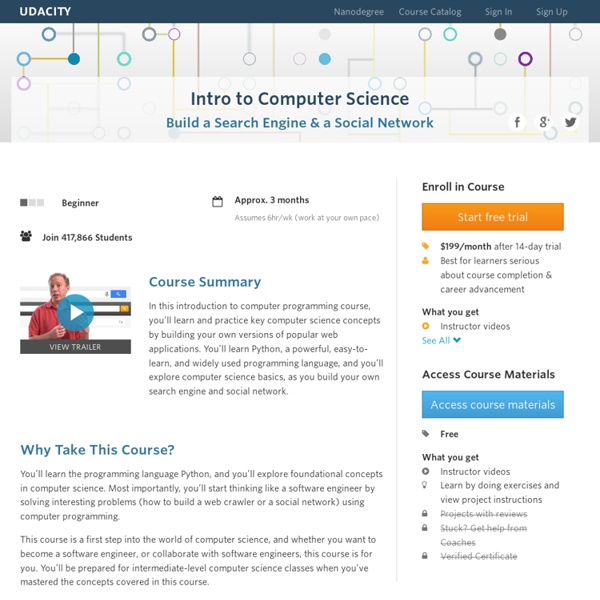Girls Who Code
Design of Computer Programs: Programming Principles
When does the course begin? This class is self paced. You can begin whenever you like and then follow your own pace. It’s a good idea to set goals for yourself to make sure you stick with the course. How long will the course be available? This class will always be available! How do I know if this course is for me? Take a look at the “Class Summary,” “What Should I Know,” and “What Will I Learn” sections above. Can I skip individual videos? Yes! How much does this cost? It’s completely free! What are the rules on collaboration? Collaboration is a great way to learn. Why are there so many questions? Udacity classes are a little different from traditional courses. What should I do while I’m watching the videos? Learn actively!
Networks, Crowds, and Markets: A Book by David Easley and Jon Kleinberg
In recent years there has been a growing public fascination with the complex "connectedness" of modern society. This connectedness is found in many incarnations: in the rapid growth of the Internet and the Web, in the ease with which global communication now takes place, and in the ability of news and information as well as epidemics and financial crises to spread around the world with surprising speed and intensity. These are phenomena that involve networks, incentives, and the aggregate behavior of groups of people; they are based on the links that connect us and the ways in which each of our decisions can have subtle consequences for the outcomes of everyone else. Networks, Crowds, and Markets combines different scientific perspectives in its approach to understanding networks and behavior. The book is based on an inter-disciplinary course that we teach at Cornell. You can download a complete pre-publication draft of Networks, Crowds, and Markets here.
Robocode Home
6 Inspiring Websites That Teach You To Code
How to Code
During the month of December, Computer Science Education Week is promoted and is a national movement for students in K-12 schools. Computer Science is an important subject or concept to teach students because it will teach them: about meaningful contextthe learning process break down complex ideas into simpler ideascollaborate with otherskeep calm and move on when frustration sets insparks their creativity and critical thinking skills These are just a few benefits of learning to code. Students today are surrounded by so much technology, that they should have a better understanding of how it really works. Here are a few websites that will help students get started on coding. 1- Code Academy This by far the most popular of them all. 2- Girl Develop It One of many programs geared toward females who want to code, Girl Develop It is an international nonprofit that provides mentorship and instruction. 3- Udacity Computer Science Course ( not free) 4- Teamtreehouse 5-The Computer Club House
Mooc « décoder le code »
Motor cognition
The concept of motor cognition grasps the notion that cognition is embodied in action, and that the motor system participates in what is usually considered as mental processing, including those involved in social interaction.[1] The fundamental unit of the motor cognition paradigm is action, defined as the movements produced to satisfy an intention towards a specific motor goal, or in reaction to a meaningful event in the physical and social environments. Motor cognition takes into account the preparation and production of actions, as well as the processes involved in recognizing, predicting, mimicking and understanding the behavior of other people. This paradigm has received a great deal of attention and empirical support in recents years from a variety of research domains including developmental psychology, cognitive neuroscience, and social psychology. Perception-action coupling[edit] Shared representations between other and self[edit] Motor priming[edit] Social facilitation[edit]
Scratch 1.4 Download
ScratchEd An online community for educators using Scratch, with stories, discussions, and resources, such as the Scratch curriculum guide. Scratch Wiki The Scratch Wiki contains a wide variety of articles by Scratchers for Scratchers, including advanced topics and tutorials. Scratch 2 Offline Editor Download the Scratch 2 offline editor. Scratch 1.4 Download Links and information on the previous version of Scratch. Scratch Statistics Explore up-to-date statistics about the Scratch online community. Scratch and the Physical World Connect your Scratch projects to the physical world with MaKey MaKey, LEGO WeDo, or PicoBoard. Scratch Logo Access the Scratch logo and other media files.



